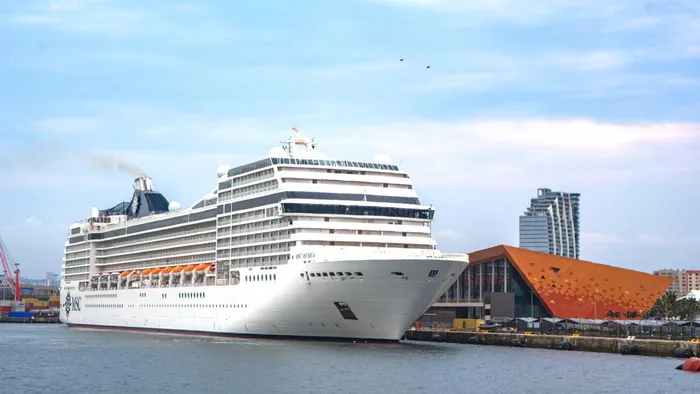KwaZulu-Natal sets sail

Sibusiso Gumbi, the interim Chief Executive of the KwaZulu-Natal Tourism and Film Authority.
Image: Supplied
KWAZULU-NATAL is charting a bold course in African cruise tourism, with the province’s record-breaking 2025/26 season set to bring a surge in visitors, jobs, and investment to its shores.
When the first gleaming cruise liners edge into KwaZulu-Natal waters this month, they signal more than the start of another summer season - they mark the province’s resurgence as Africa’s most dynamic coastal destination. The 2025/26 cruise season is expected to welcome 255 000 passengers, generating R1.9 billion in economic impact, supporting 3 400 jobs, and stimulating growth across hospitality, retail, transport, and creative industries.
On Friday (November 7) KZN Tourism and Film participated at the Interprovincial Cruise Tourism Workshop at the Nelson Mandela Cruise Terminal which brought together government, industry, and private-sector leaders to align KwaZulu-Natal’s cruise ambitions with national strategies. The gathering underscored one message: that the province’s success will depend on collaboration, investment, and the ability to translate passenger arrivals into meaningful local benefit.

Durban is gearing up for the 2025/26 cruise season.
Image: Supplied
The Strategic Shift Behind KZN’s Cruise Boom
Since 2022, global cruise lines have diverted from the Red Sea due to heightened security risks, rerouting via the Cape of Good Hope. This shift created an unexpected opportunity for South Africa - and particularly KwaZulu-Natal - to position itself as a safe and scenic stopover along the Cape Sea Route.
What began as a temporary deviation is now a long-term strategic advantage, as more international vessels choose Durban and Richards Bay for their safety, scenic routes, and seamless passenger experiences. The result has been a surge in ship calls, longer port stays, and higher local economic spend, particularly on tourism.
A Turning Tide for Durban
For years, Durban was viewed as a logistical port rather than a destination. Today, the state-of-the-art Nelson Mandela Cruise Terminal and a revitalised Durban Waterfront have positioned it as a key gateway to KwaZulu-Natal’s broader tourism network. With global lines like MSC, AIDA, and Cunard adding more African itineraries, Durban has emerged as a vital link between the Atlantic and Indian Oceans.
Durban’s transformation did not happen in isolation. Infrastructure investment, improved safety, and strong City and Provincial marketing have rebranded it as a warm, efficient, and culturally rich destination. From the bustling Golden Mile to the panoramic arch of Moses Mabhida Stadium, the city now embodies a cruise-ready blend of leisure and authenticity. Yet the true measure of success lies beyond its shores - in how the entire province benefits from this maritime momentum.
Anchoring Growth in Local Experience
Cruise passengers typically spend between 24 and 72 hours in port, and KwaZulu-Natal is determined to make every hour count. Travellers are increasingly venturing to other KZN destinations beyond Durban - to the Midlands Meander’s artisan villages, the Valley of a Thousand Hills’ cultural enclaves, and the historical heartlands of Inanda and Umlazi to the northern regions such as Hluhluwe game reserves and Isimangaliso Wetland parks that offer world class safari experiences. These multi-day excursions turn stopovers into immersive journeys, generating real economic benefit for small businesses and communities across the province.
The province is developing short-stay and extended itineraries that showcase its diversity - from craft markets and culinary tours to eco-adventure trails along the “Blue Route” linking Richards Bay to Port Shepstone. This approach ensures cruise tourism uplifts both coastal and inland destinations, turning KwaZulu-Natal into a holistic travel experience rather than a single stop.
At the same time, film and tourism are working hand in hand. Productions shot across the province - from the Nelson Mandela Capture Site to the Port of Richards Bay - serve as cinematic postcards to the world. This synergy amplifies destination visibility and reinforces the province’s unique dual mandate: to tell stories that inspire travel.
Beyond economic metrics, KwaZulu-Natal’s cruise growth is also about people. Each docking supports township guides, local artisans, game reserves, and family-run restaurants. Cruise tourism is helping women- and youth-owned businesses thrive, creating a more inclusive ocean economy that reflects the province’s diversity and strengthens its reputation for authentic, people-centred travel.
KZN Is Building Momentum
KwaZulu-Natal is building momentum through the Provincial Cruise Tourism Strategic Framework which is anchored around the following five pillars:
- Data-driven decision-making to measure social and economic impact.
- Infrastructure enhancement across ports and tourism attractions.
- International marketing to position KZN competitively.
- Product diversification through new short-stay and multi-day tours.
- Institutional coordination to strengthen collaboration and delivery.
Its guiding principle is clear: terminals don’t make destinations - experiences do.
Collaboration Across the Industry
Cruise tourism thrives on coordination. From port logistics to immigration, each stakeholder contributes to the traveler’s journey. The Interprovincial Workshop reaffirmed that operational excellence, safety, and destination marketing must work in harmony.
The shared goal is to position KwaZulu-Natal not merely as a port of call but as Africa’s cruise hub - where efficiency meets warmth and every visitor leaves as an ambassador.
The Economic Horizon
The 2025/26 season is forecast to deliver a 56% increase in cruise calls compared with 2023/24. This momentum is already catalysing urban renewal, SMME participation, and investor confidence. Hospitality brands are expanding, entrepreneurs are innovating with water-based excursions and artisan retail, and youth training initiatives are preparing the next generation of maritime professionals.
Globally, the cruise industry’s rebound is accelerating, with passenger volumes projected to surpass pre-2020 levels by 2026. KwaZulu-Natal’s readiness ensures that South Africa secures a meaningful share of this growth.
Charting the Course Ahead
For KZN Tourism & Film, cruise tourism is not just about arrivals - it’s about lasting impact. It stimulates enterprise in coastal towns, enhances infrastructure resilience, and redefines the province’s global image. Continued progress will depend on better data, simplified visa processes, and year-round product readiness.
The forthcoming Cruise Africa Association (CAA) will serve as a continental coordination platform, giving Durban, Richards Bay, and other ports a unified voice in the international market. As vessels like Queen Mary 2 and Costa Deliziosa drop anchor along the KZN coast, they bring validation that the province has matured into a world-class cruise destination.
A New Era for KwaZulu-Natal
KwaZulu-Natal’s cruise resurgence is more than a tourism milestone - it is a statement of intent. When infrastructure meets imagination, ports become portals to pride and progress. The waves rolling into its harbours today echo the rhythm of a province charting its own course in the global maritime economy. With the right partnerships and vision, KwaZulu-Natal will not just host cruise ships - it will steer the future of African coastal tourism.
Sibusiso Gumbi is the interim CEO, KZN Tourism and Film.
The views expressed do not necessarily reflect those of the Sunday Tribune or IOL.
Related Topics: